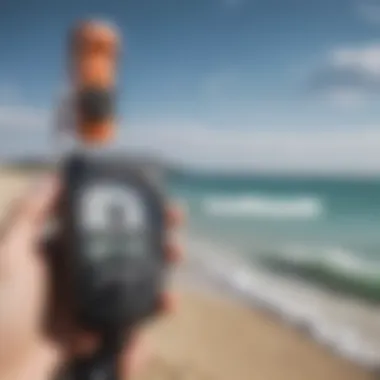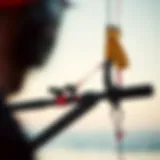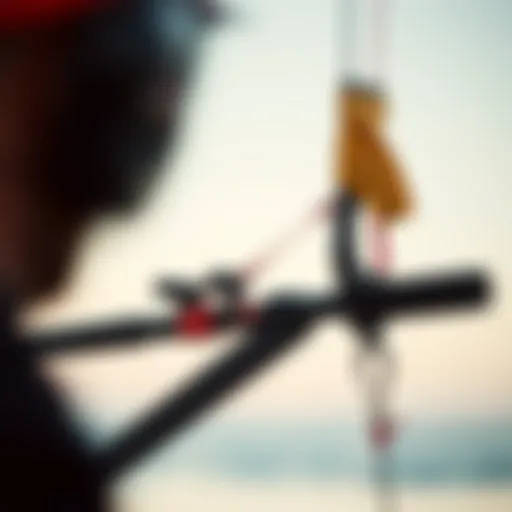Understanding WiFi Wind Speed Meters for Kiteboarding


Intro
In the world of kiteboarding, understanding the conditions of the wind is crucial for an exhilarating experience on the water. WiFi wind speed meters have emerged as indispensable tools for enthusiasts, allowing real-time data and analysis of wind conditions. This blend of technology and sport not only improves the thrill but also enhances safety. Kiteboarders wish to catch the perfect gust at just the right moment, and knowing wind speed through these devices helps make that happen.
WiFi wind speed meters function by capturing wind velocity and transmitting this data wirelessly, enabling users to monitor conditions from afar. As kiteboarding becomes increasingly popular, these gadgets offer significant advantages ranging from precision in wind speed evaluation to integration with mobile devices, essentially putting every kiteboarder's wish within grasp. This article will guide you through the operation, benefits, and maintenance of these wind speed meters, ensuring that knowledge is your greatest ally when on the water.
Gear Selection
Selecting the right gear is fundamental for any kiteboarding adventure, particularly when it comes to ensuring that wind conditions align with your equipment. Whether you're a seasoned pro or venturing into the scene for the first time, here’s what to consider.
Types of Kites
The kite you choose plays a massive role in how well you'll handle differing wind speeds. Broadly, there are three types of kites:
- Foil Kites: These kites are great for low wind conditions due to their ability to generate lift even with limited airflow. Ideal for newbies, they also pack down compactly, making them perfect for travel.
- LEI Kites (Leading Edge Inflatable): Most popular among kiteboarders, LEI kites perform excellently in various wind conditions. They're versatile, forgiving, and suitable for both beginning and advanced riders.
- Hybrid Kites: Combining elements of both foil and LEI kites, hybrids offer a balance between ease of use and performance. They adapt well to dynamic winds and are great for those who want a little bit of everything.
Choosing the Right Board
Accompanying your kite with the right board ensures maximum performance and control. Consider the following factors:
- Board Size: Larger boards generally provide more stability and are suited for lighter winds. Smaller boards are better for stronger winds due to their responsiveness, which helps in tricks and quick turns.
- Board Shape: Options include directional and twin tip boards. Directional boards are typically used with surf-style kites and provide a different type of ride, while twin tips help in various conditions, making them popular among free riders.
- Material: Boards can come in wood, composite materials, or a mix of both. Each offers unique advantages in terms of weight, durability, and cost.
Selecting the right kite and board, paired with your WiFi wind speed meter, sets you up for success on the water. It’s about finding that sweet spot where equipment meets conditions, bringing every kiteboarder's fantasy to life.
Preface to Wind Measurement
Wind measurement is more than just knowing if it’s breezy outside; it's an essential element for various outdoor sports. In particular, kiteboarding, where wind conditions dictate performance and safety, heavily relies on accurate wind measurements. By comprehending the intricacies of wind measurement, kiteboarders can make informed decisions to enhance their experiences on the water.
Historical Context
To appreciate the present-day wind measurement techniques, one must understand where it all began. Historically, wind measurement tools have evolved significantly. The earliest devices, such as simple wind vanes, barely hinted at the precision we have today. Those days, sailors would gauge the wind by observing its effects; now there are sophisticated anemometers that provide real-time readings. As kiteboarding grew as a sport, it influenced the demand for more reliable tools, prompting innovations in technology—often in line with improvements in general meteorology.
Importance of Accurate Wind Measurements in Kiteboarding
Accurate wind measurements are crucial for kiteboarding, where adverse conditions can spell disaster. Wind speed, its direction, and gusts inform riders when to take to the skies or remain grounded. Kiteboarders face varying abilities and preferences, meaning that what constitutes ideal conditions can differ greatly among them.
"A kiteboarder’s experience hinges on understanding the wind, with too much or too little effectively ruining the day."
Moreover, knowing the wind's behavior helps in selecting the right gear; a larger kite may be necessary for light winds, while stronger winds require smaller kites.
Kiteboarding enthusiasts also face inconsistent conditions as wind patterns fluctuate from one moment to the next. Therefore, integrating precise wind measurement technology into their routines provides peace of mind, allowing them to enjoy their passion without the worry of unpredictable conditions.
In summary, as we delve deeper into the world of wind measurements, we uncover a landscape rich in history, laden with challenges and full of adventure. Understanding the foundational elements of wind measurement sets the stage for maximizing kiteboarding performance.
Technology Behind WiFi Wind Speed Meters
The emergence of WiFi wind speed meters has revolutionized the way kiteboarders gauge wind conditions. This technology not only enhances accuracy but also simplifies data analysis, making it crucial for enthusiasts and professionals alike. Understanding the technology that powers these devices clarifies their benefits and considerations when integrated into the kiteboarding experience.
Basic Mechanics
At the heart of a WiFi wind speed meter lies its mechanical components, which play an essential role in measuring wind velocity. Most devices use an anemometer, which can either be a rotating cup system or a vane system. Each design has its perks. For instance, a cup anemometer counts the revolutions of its rotating cups to calculate wind speed. The faster the wind, the quicker the cups spin. Conversely, a vane anemometer captures wind direction and offers readings based on static pressure differences.
This is how these devices come to life:
- Durability: Designed to withstand harsh weather conditions, ensuring longevity.
- Sensitivity: Capable of detecting even subtle changes in wind patterns, vital for activities like kiteboarding.
- Calibration: Many units come pre-calibrated, but users should routinely check that they are set correctly for precise measurements.
These elements work harmoniously, ensuring that readings reflect the true wind conditions experienced while kiteboarding. It's a complex dance of physics at play.
Data Transmission and Communication
Once the readout is gathered, the next critical step involves data transmission. WiFi wind speed meters utilize wireless technology to communicate readings. This ability to relay information in real-time is what sets them apart. Users can access live data on smartphones or tablets, allowing for quick decisions about when and where to kiteboard.
Some important aspects of data transmission are:


- WiFi Connectivity: Many devices connect effortlessly to existing networks, enabling broad access.
- Mobile Compatibility: Most models come with dedicated apps that enhance user experience. For example, the app may provide graphs illustrating wind trends over time, greatly aiding in decision-making.
- Alert Systems: Certain meters can send alerts when wind reaches a designated threshold, an invaluable feature to stay safe on the water.
"The ability to see real-time data can make or break a session on the water; understanding wind patterns is just as important as having the right gear."
Types of WiFi Wind Speed Meters
Understanding the different types of WiFi wind speed meters is essential for kiteboarders who want precision in their sport. These devices vary in functionality, portability, and integration capabilities. Each type caters to different purposes and environments. Recognizing these distinctions can greatly enhance a kiteboarder's experience and decision-making while navigating various wind conditions.
Portable Units
Portable wind speed meters are designed for on-the-go convenience. These handheld devices are lightweight and compact, allowing kiteboarders to easily carry them to various locations. Their primary advantage lies in their user-friendliness and quick setup. You can often just switch them on and start measuring within seconds, which is super handy when you're at the beach or heading out for a session.
Key Benefits:
- Portability: They fit easily into a backpack or even a pocket, making them perfect for travel.
- Simplicity: With straightforward interfaces, portable units are typically designed for rapid data retrieval.
- Immediate Feedback: Thanks to real-time readings, they allow for quick adjustments to kiteboarding plans based on current conditions.
It's also worth mentioning that while they are great for immediate data access, portable units may not have the same level of accuracy as larger systems. They serve well for quick checks but rely on skilled interpretation for precision in tricky conditions.
Fixed Installation Meters
In contrast, fixed installation wind speed meters offer a more permanent solution for measuring wind in specific locations. Installed at a designated site, these meters provide continuous and often more accurate readings. This is particularly crucial for kiteboarding schools, event organizers, or locations where people frequently gather for wind sports.
Advantages Include:
- Accuracy: Fixed meters usually have higher calibration standards compared to their portable counterparts, making them reliable for long-term data tracking.
- Emphasis on Data Collection: They can often store historical data, which provides insights into wind patterns over time, assisting in strategic planning for kiteboarding sessions.
- Integration with Weather Stations: Some models can be integrated into broader weather systems, providing comprehensive weather analytics.
A potential pitfall could be their immobility. Since they are installed at a specific spot, this limits their use to that environment only. However, for those who regularly kiteboard in the same locations, the long-term investment might just be worth it.
Smart Devices Integration
The wave of smart technology has equally stretched into wind measurement. Many modern wind speed meters now offer integration with smartphones and other smart devices. This option is hugely appealing to tech-savvy kiteboarders who relish having their data at their fingertips.
Here’s what to keep in mind:
- Connectivity: Many of these meters pair with smartphone apps via Bluetooth or WiFi, allowing users to monitor wind conditions closely and remotely.
- Data Visualization: Smart integrations often include features like graphs and alerts, enabling kiteboarders to make informed decisions without being physically present at the measurement point.
- Compatibility with Other Tech: Some meters can sync with GPS devices and action cameras, enhancing the overall kiteboarding experience.
However, reliance on technology can sometimes lead to oversimplifying the nuances of reading natural conditions, which is still inherently variable.
"Piloting your kite requires not just knowledge of the wind, but an understanding of how technology complements nature's whims."
In summary, identifying the type of WiFi wind speed meter that best suits your kiteboarding needs is crucial. Each type serves a different purpose, with its own set of advantages and drawbacks. A kiteboarder's choice will likely hinge on their specific requirements, frequency of measurement, and whether they prefer the immediacy of data access or the reliability that comes from fixed installations.
Advantages of Using WiFi Wind Speed Meters
Utilizing WiFi wind speed meters comes with a handful of significant advantages that can enhance the kiteboarding experience, improving safety and performance. These devices have quickly become essential tools for kiteboarders, instructors, and event organizers alike. Having the latest wind information at one’s fingertips can translate to not just better rides, but a more enjoyable time on the water overall.
Real-Time Data Access
One of the standout features of WiFi wind speed meters is the ability to access data in real time. This eliminates the unpredictable factors associated with checking weather forecasts or waiting for someone to relay information.
- Instant Decision Making: With real-time data, kiteboarders can make swift decisions, such as whether to head out or to pause until conditions improve. This immediacy helps prevent accidents that might occur when winds change unexpectedly.
- Location-Specific Information: These devices don’t just give general wind conditions; they provide localized readings from the specific site. This is particularly useful for kiteboarding, as conditions can vary even within short distances.
"Having real-time data is like having a crystal ball. It takes the guesswork out of deciding when to hit the water."
Enhanced Decision Making for Kiteboarding
In the kiteboarding world, knowledge is power. The insights gained from using WiFi wind speed meters empower kiteboarders to make informed choices about their activities.
- Safety First: Knowing the exact wind speed and direction allows kiteboarders to assess safety proactively. It helps prevent those tricky and sometimes dangerous situations where the wind may turn stronger than expected.
- Optimizing Conditions: When kiteboarders have access to accurate data, they can optimize their lines and gear, matching their selections to current weather conditions. This adaptive decision-making leads to a more fulfilling experience during a kiteboarding session.
Integration with Other Technologies


WiFi wind speed meters are often compatible with other technological advances, adding layers of functionality.
- Smartphones: Many of these meters integrate seamlessly with apps on smartphones. Users can check readings from afar, allowing them to stay informed while preparing equipment at a distance – one less hassle before heading out.
- Other Weather Sensors: When combined with additional sensors, such as temperature or humidity gauges, kiteboarders can get a comprehensive view of the atmospheric conditions affecting their sport. It becomes possible to analyze patterns over time, equipping users to foresee when conditions will be optimal.
- Data Sharing: Integration with social platforms, like Facebook and Reddit, allows users to share their readings with fellow kiteboarders. This communal aspect fosters a network of information, creating a larger community focused on safety and enjoyment.
Operating WiFi Wind Speed Meters
Operating WiFi wind speed meters is not just a technical interest; it's vital for maximizing enjoyment and safety while kiteboarding. Understanding how to properly handle these devices can directly influence a rider’s ability to gauge wind conditions accurately. With the right tools and knowledge, kiteboarders can read the rhythm of the wind, leading to better performance and a safer experience on the water.
Setup Instructions
Setting up a WiFi wind speed meter might feel daunting at first, but once you get the hang of it, it’s pretty straightforward. Begin by unboxing your device and inspecting it for any visible damage. After that, follow these steps:
- Find a Suitable Location: Choose an open area away from buildings or trees. Obstructions can interfere with wind flow and affect readings.
- Mounting the Device: Depending on the model, use the provided mount or bracket firmly. If it’s a portable unit, ensure you can easily retrieve it after use.
- Powering On: Activate the device and ensure it connects to your WiFi. Most modern meters will guide you through this process via an app.
- Connect to Your Smartphone: Download the manufacturer’s app. This allows for real-time monitoring and adjustments.
- Test the Connection: Ensure that your wind speed meter is properly communicating with your phone. It’s essential to have a stable connection before hitting the water.
By following these steps carefully, you set the stage for effective use of the wind speed meter.
Calibrating Your Device
Calibration is key. Think of it as fine-tuning a musical instrument. A well-calibrated wind speed meter provides accurate and reliable data. Here’s how to ensure your device sings in harmony with nature:
- Follow Manufacturer Guidelines: Refer to the user manual; different models have various calibration requirements.
- Environmental Considerations: Calibration may vary depending on where you’re using it. For example, calibrate it for sea level if you’re at the beach.
- Testing Against a Known Standard: If possible, compare readings against a trusted local weather station or a handheld anemometer.
- Regular Adjustments: Consider calibrating your device every few months or after significant changes in location or atmospheric conditions.
Proper calibration can make all the difference, elevating your forecasting abilities significantly.
Understanding Readings and Interpretations
When it comes to understanding the readings from your WiFi wind speed meter, comprehension is everything. Knowing how to interpret data can turn a good kiteboarding day into a great one. Here are some keys to understanding the readings:
- Wind Speed Measurements: Most meters display speed in miles per hour (MPH) or kilometers per hour (KPH). Familiarize yourself with what these numbers mean for your kiteboarding equipment (like minimum and maximum speeds).
- Graphs and Patterns: Many apps visualize data in graphs. Identify patterns over time instead of relying on single-day readings – it’ll help you anticipate weather changes.
- Comparative Data: Use previous readings to understand trends. For example, if wind speeds tend to drop in late afternoon, plan your kiteboarding sessions accordingly.
"With knowledge, kiteboarding opens up to an art where you're not just riding waves; you're dancing with the wind."
By fully grasping how to read and interpret the data from your device, you enhance your kiteboarding experience, making informed decisions that align with your skillset and safety.
Maintenance and Care
Maintaining your WiFi wind speed meter can feel like a chore, but it’s crucial for longevity and accuracy. Regular upkeep not only increases the lifespan of the device, but also ensures that your readings remain dependable for those all-important kiteboarding moments. A well-cared device can mean the difference between a perfect day on the water and a risky venture into unfavorable conditions.
Routine Checks
Conducting routine checks is essential to keeping your wind speed meter operating at peak performance. Schedule a bi-weekly inspection to ensure the following:
- Battery Status: Check if the batteries are fresh. Old batteries can give unreliable readings. If you notice any drop in performance, consider replacing the batteries sooner rather than later.
- Calibration: Some meters require recalibration after rough use. Review the manufacturer's instructions for intervals.
- Physical Condition: Inspect the meter for signs of wear, like cracks or dirt accumulation that could obstruct data transmission.
Devoting a little time each week can save you considerable hassle when you’re ready to hit the waves.
Troubleshooting Common Issues
Inevitably, you might run into a snag or two with your device. Knowing how to troubleshoot can save you both time and heartache.
- No Data Transmission: If your meter fails to send data, first check your WiFi connection. Is your device still connected? If the signal seems weak, try moving closer to the router or resetting the device.
- Erroneous Readings: If you spot wind speeds that don’t sit right, reset the device. Sometimes the internal sensors can get a bit wonky and a simple reboot fixes that.
- App Connectivity Issues: For those meters that sync with an app, make sure the app is up to date. Updating often resolves connectivity problems.
"Regular maintenance isn��’t just about fixing things; it's about preserving the integrity and functionality of your tools."
Having a tried-and-tested troubleshooting guide on hand can save the day when you’re gearing up for an adventure.
Optimal Storage Practices
Proper storage can dramatically affect the durability of your wind speed meter. You wouldn’t leave your kite folded up in a damp corner, would you? Treat your meter with the same care.
- Dry and Cool Environment: Store in a place away from direct sunlight and humidity. Excess moisture can corrode electronic components.
- Use Protective Cases: If your meter came with a travel case or you can purchase one, use it. This avoids physical damage during transport.
- Keep Batteries Out During Long Periods of Non-Use: Remove batteries if you won’t be using your device for an extended period. It prevents leaks that might ruin the battery compartment.


Employing these storage strategies ensures that when you're ready to take to the skies, your equipment is in top-notch condition.
Impact on Kiteboarding Performance
When kiteboarding, the performance hinges not solely on the rider’s skill but heavily on understanding the wind dynamics at play. Wind speed greatly influences kite control, profoundly affecting how a kite responds during maneuvers, take-offs, and landings. WiFi wind speed meters provide critical data that helps kiteboarders adapt their strategies in real-time, enhancing their overall experience and safety.
Effects of Wind Speed on Kite Control
Wind speed is a kiteboarder's best friend or worst enemy. At the core of kite control is the relationship between wind speed and kite performance. Here’s how this dynamic unfolds:
- Low Wind Speeds: In lighter winds, a kite may struggle to generate lift, which means jumps and tricks become challenging. Under these conditions, a larger kite is recommended. Its increased surface area harnesses more wind, enabling more lift even when the breeze is soft.
- Moderate Wind Speeds: This is where many riders thrive; the wind is just right, providing enough power without overwhelming them. Keeping an eye on the wind speed through WiFi meters helps kiteboarders time their actions perfectly, ensuring they utilize the optimal wind for tricks while maintaining control.
- High Wind Speeds: Strong winds can turn exhilarating into overwhelming very quickly. In such conditions, the risk of losing control is significant, especially for less experienced riders. WiFi wind speed meters indicate when to switch to a smaller kite, allowing riders to stay within safe parameters while still enjoying the thrill of high-speed riding.
In essence, the right data translates into better performance. With access to real-time wind information, kiteboarders can adjust their kites and techniques, ensuring that every ride is both thrilling and safe.
Choosing the Right Conditions Based on Data
As any seasoned kiteboarder knows, waiting for the right moment is key. WiFi wind speed meters offer practical insights that assist riders in pinpointing the best conditions for their venture. Based on the data provided:
- Understanding Ideal Conditions: Each kite and rider duo performs best at specific wind speeds. By referencing the meter's readings, one can determine the ideal conditions tailored to their gear and skill level. This not only maximizes thrill but also minimizes risk.
- Planning Sessions Accordingly: A useful feature of many WiFi wind meters is their ability to record historical data. This way, riders can analyze past sessions, identifying trends in wind speed and conditions, helping them select the perfect days for future kitesurf outings.
- Safety-Led Decisions: When conditions become too windy, it's advisable to pack up rather than risk injury. Having reliable data at hand is crucial; it empowers kiteboarders to make prudent decisions, keeping both safety and enjoyment at the forefront.
"To harness the wind effectively, one must first understand it. Accurate wind data leads to safer and more enjoyable kiteboarding experiences."
In summary, the impact of wind speed on the performance of kiteboarding cannot be understated. Understanding how to interpret wind data from WiFi meters allows riders to enhance their control, choose suitable conditions, and ensure a safer, more thrilling experience every time they hit the water.
Challenges and Limitations
When discussing WiFi wind speed meters, it’s not all smooth sailing. Recognizing the challenges and limitations surrounding these instruments is essential for kiteboarders who rely on accurate data to enhance their experience. These devices may hold significant promise, but factors like data reliability and environmental influences can impact their efficiency and the decision-making process, which is crucial in kiteboarding scenarios.
Data Reliability
The reliability of data sourced from WiFi wind speed meters is paramount, especially when your safety and performance depend on it. These devices often depend on algorithms to interpret wind conditions based on the information they gather. If these algorithms are inaccurate, the data can lead to poor decisions, affecting not only performance but safety as well.
- Calibration: How often the device is calibrated can impact its data reliability. For instance, a device that hasn't been calibrated recently may report wind speeds that are off by a significant margin. Ensuring regular calibration is, therefore, a key aspect that kiteboarders should prioritize.
- Software Updates: Manufacturers occasionally release updates that can improve accuracy. Failing to keep your device updated may leave you using outdated algorithms that don’t reflect current wind patterns.
- User Error: Sometimes it boils down to the operator. If a user misinterprets the data or sets up the device incorrectly, it undermines the potential of even the best equipment.
Ultimately, understanding that not all data is created equal and taking measures to ensure its reliability can significantly enhance kiteboarding experiences.
Environmental Influences on Readings
In outdoor sports like kiteboarding, mother nature has a significant role to play. Various environmental factors can lead to discrepancies in the readings provided by WiFi wind speed meters, affecting their reliability.
- Obstructions: Trees, buildings, or other structures can create wind shadows. If a meter is set up close to these obstacles, the readings may not reflect the true wind conditions, sometimes showing lower speeds than what the kiteboarder will experience in open water.
- Temperature Variations: Rapid changes in temperature can affect wind density and speed, leading to fluctuations in the data transmitted from the device. For example, if there’s a sudden drop in temperature, a wind speed meter may report lower speeds, adversely affecting a kiteboarder's swell trajectory.
- Humidity Levels: High humidity can alter wind patterns, making it difficult for the meter to provide accurate information. High moisture in the air can also cause electronic devices to function less predictably.
These environmental factors underline the necessity for kiteboarders to not just rely on the digital data provided by their meters, but also to develop a keen understanding of their surroundings for enhanced judgement.
In summary, while WiFi wind speed meters are invaluable tools for kiteboarders seeking to optimize their experience, it’s critical to be mindful of the challenges and limitations. Data reliability and environmental influences are aspects that cannot be overlooked; embracing them facilitates smarter decisions and potentially more pleasurable rides.
Future Trends in Wind Measurement Technology
As kiteboarding continues to gain traction, the role of technology in this sport becomes increasingly critical. Among the most significant advancements is the evolution of wind speed meters. Understanding the future trends in wind measurement technology not only informs kiteboarders about what to expect but also empowers them to harness these innovations for a better riding experience. This section will explore emerging innovations and potential developments, particularly in how these advancements can be integrated with smartphones for improved user experience.
Emerging Innovations
In the realm of wind measurement, innovation is the name of the game. One noteworthy trend is the integration of machine learning algorithms into wind measurement devices. These algorithms enable devices to process large sets of data, thus providing more accurate readings in real time. For example, a wind speed meter that uses machine learning can learn from past wind patterns, anticipating changes and offering predictions based on real-time data.
Another innovation is the miniaturization of sensors. These smaller, lighter sensors can be seamlessly integrated into wearable devices such as vests or harnesses. Imagine a kiteboarder sporting a smart vest with built-in sensors that measure wind speeds, providing feedback directly to their smartphone while they ride. Such innovations could change how riders interact with their environment, making data immediately actionable and enhancing overall performance.
Moreover, solar power is set to play a pivotal role in the future. Wind speed meters that incorporate solar panels will allow for prolonged usage without worrying about battery drain. This not only promotes eco-friendliness but also makes data collection more consistent, especially in remote areas where access to power sources can be a challenge.
Potential Developments in Smartphone Integration
Smartphone integration is another frontier that holds tremendous potential. Currently, many wind speed meters can connect to smartphones via apps, but the future promises a more nuanced interaction. For instance, augmented reality (AR) could revolutionize how riders perceive wind conditions. By pointing a smartphone at the sky, a rider could use an AR application to visualize wind speed, direction, and gusts in real-time.
Also, enhanced data sharing is on the horizon. Imagine being able to share wind conditions with a community of kiteboarders locally or globally with just a click. By integrating GPS and social media features, riders could post live updates about wind conditions at their location. This connectivity can foster a sense of community and help fellow kiteboarders make informed decisions about where to ride.
"The wind is both an ally and an adversary; understanding it is the key to mastering the sport."
Keeping an eye on these trends will ensure that kiteboarders remain equipped with the tools necessary for informed decision-making, ultimately enhancing their overall performance.















